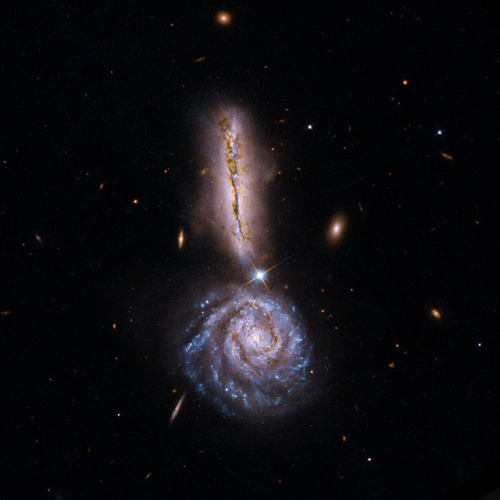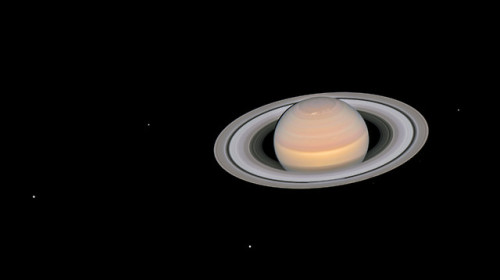VV 340, Pair Of Interacting Galaxies In Boötes. The Two Galaxies Shown Here Are In The Early Stage Of

VV 340, pair of interacting galaxies in Boötes. The two galaxies shown here are in the early stage of an interaction that will eventually lead to them merging in millions of years.
Credit: NASA/STScI/NRAO/A.Evans et al
More Posts from Riekod and Others
[Mathematics is] a very powerful and effective language invented by humans to describe and discover patterns in nature. When we perceive beauty in the mathematics, I think what we’re really perceiving is an underlying beauty in nature itself.
Jim Baggott, Quantum Space

The edges of this flame are black. No camera trickery, no special effects. What’s going on here is down to some interesting science and some excited electrons.
When you burn sodium it emits a monochromatic yellow/orange light. This happens because when sodium heats up, electrons in the atom’s orbitals become excited and they jump up to a higher energy level. When they drop back down to their original energy level they release a photon of light of a specific wavelength, which for sodium is yellow/orange.
As well emitting photons, sodium atoms also absorb photons of the same wavelength. That means if you have a light source emitting the same monochromatic light (like the sodium street lamp which we have here) the sodium atoms in the flame will absorb the light making the flame look dark.
For more flame filled visuals and a more detailed explantation of this phenomenon, check out our latest video https://www.youtube.com/watch?v=Kn2OyQh6o7U
Tools of the Trade: How Parker Solar Probe Will Study the Sun
Our Parker Solar Probe will get closer to the Sun than any spacecraft has ever gone – it will fly right through the Sun’s corona, part of the Sun’s atmosphere.

This spacecraft is full of cutting-edge technology, from its heat shield down to its guidance and control systems. It also carries four suites of advanced instruments designed to study the Sun in a multitude of ways.
1. Measuring particles
Two of Parker Solar Probe’s instrument suites are focused on measuring particles – electrons and ions – within the corona.
One of these particle-measuring instrument suites is SWEAP (Solar Wind Electrons Alphas and Protons). SWEAP counts the most common particles in the solar wind – the Sun’s constant outflow of material – and measures their properties, like velocity, density and temperature. Gathering this information about solar wind particles will help scientists better understand why the solar wind reaches supersonic speeds and exactly which part of the Sun the particles come from.

One instrument in the SWEAP suite is the Solar Probe Cup. Most of the instruments on Parker Solar Probe stay safe and cool in the shadow of the heat shield, but the Solar Probe Cup is one of the few that sticks out. That’s so it can capture and measure particles streaming straight out from the Sun, and it had to go through some intense testing to get ready for this position in the Sun’s incredibly hot corona.

Credit: Levi Hutmacher/Michigan Engineering
The ISʘIS suite (pronounced EE-sis, and including the symbol for the Sun in its acronym) also measures particles. ISʘIS is short for Integrated Science Investigation of the Sun, and this instrument suite measures particles that move faster – and therefore have more energy – than the solar wind.
These measurements will help scientists understand these particles’ lifecycles – where they came from, how they got to be traveling so fast (these particles can reach speeds more than half the speed of light!) and what path they take as they travel away from the Sun and into interplanetary space.

2. Taking pictures – but not of the Sun’s surface.
WISPR (Wide-Field Imager for Parker Solar Probe) has the only two cameras on Parker Solar Probe – but they’re not pointed directly at the Sun. Instead, WISPR looks out the side of the spacecraft, in the direction it’s traveling, looking at the space Parker Solar Probe is about to fly through. From that vantage point, WISPR captures images of structures within the corona like coronal mass ejections, or CMEs. CMEs are clouds of solar material that occasionally explode from the Sun at millions of miles per hour. Because this solar material is magnetized, CMEs can trigger geomagnetic storms when they reach Earth – which, in turn, can cause effects like auroras and even, in extreme cases, power outages.

Right now, our observations of events like these come from satellites orbiting near Earth, so WISPR will give us a whole new perspective. And, scientists will be able to combine WISPR’s images with Parker Solar Probe’s direct particle measurements to get a better idea of how these structures change as they travel.

3. Studying electric & magnetic fields
The FIELDS instrument suite is appropriately named: It’s what scientists will use to study the electric and magnetic fields in the corona.
Electric and magnetic fields are key to understanding what happens, not only on the Sun, but throughout space, because they are the primary driver accelerating charged particles. In particular, a process called magnetic reconnection – when magnetic field lines explosively realign, sending particles rocketing away at incredible speeds – is thought to drive solar explosions, as well as space weather effects on Earth, like the aurora.

FIELDS measures electric and magnetic field at high time resolution, meaning it takes lots of measurements in a short amount of time, to track these processes and shed some light on the mechanics underlying the Sun’s behavior. FIELDS’ measurements are precisely synced up with those of the SWEAP suite (one of the sets of instruments studying particles) so that scientists can match up the immediate effects that electric and magnetic fields have on the material of the solar wind.

Parker Solar Probe launches summer 2018 on its mission to study the Sun. Keep up with the latest on the mission at nasa.gov/solarprobe or follow us on Twitter and Facebook.
Make sure to follow us on Tumblr for your regular dose of space: http://nasa.tumblr.com.
““The reason T-Rex’s have no love life [they have short arms and can’t hold hands] is the same reason second row elements can’t make pi bonds with third row elements [not enough orbital overlap].””
— Organic chemistry prof

Saturn and its moons at opposition (The visible moons are (from left to right) Dione, Enceladus, Tethys, Janus, Epimetheus and Mimas
Credit: NASA, ESA, A. Simon (GSFC) and the OPAL Team, and J. DePasquale (STScI)




Physics: Coins in dry ice
Source: Mr. Hacker on YT

The faint rings of Uranus, shot in 1986, are made of countless fragments of water ice containing radiation-altered organic material.
Credit: NASA/JPL/Michael Benson, Kinetikon Pictures
sending your selfies to NASA because you’re a star

my type of meme

Saturn’s rings and our planet Earth and Moon in the same frame captured by nasa’s Cassini spacecraft 19 July. (source @nasa) *Out Pale Blue Dot*
-
 interstellarstorms reblogged this · 4 months ago
interstellarstorms reblogged this · 4 months ago -
 sinoh reblogged this · 1 year ago
sinoh reblogged this · 1 year ago -
 sinoh liked this · 1 year ago
sinoh liked this · 1 year ago -
 soxsick reblogged this · 1 year ago
soxsick reblogged this · 1 year ago -
 dragongoblet liked this · 2 years ago
dragongoblet liked this · 2 years ago -
 amarranthinee reblogged this · 2 years ago
amarranthinee reblogged this · 2 years ago -
 zvzxzvz liked this · 3 years ago
zvzxzvz liked this · 3 years ago -
 is-this-lit reblogged this · 3 years ago
is-this-lit reblogged this · 3 years ago -
 intrusivetoxin liked this · 3 years ago
intrusivetoxin liked this · 3 years ago -
 princessxpunk reblogged this · 4 years ago
princessxpunk reblogged this · 4 years ago -
 nlockett liked this · 4 years ago
nlockett liked this · 4 years ago -
 nlockett reblogged this · 4 years ago
nlockett reblogged this · 4 years ago -
 thirdman000 reblogged this · 4 years ago
thirdman000 reblogged this · 4 years ago -
 guardianhathaway reblogged this · 4 years ago
guardianhathaway reblogged this · 4 years ago -
 mrumf17 liked this · 4 years ago
mrumf17 liked this · 4 years ago -
 sleepy-conclusions reblogged this · 4 years ago
sleepy-conclusions reblogged this · 4 years ago -
 thirdman000 reblogged this · 4 years ago
thirdman000 reblogged this · 4 years ago -
 supersaiyanriy reblogged this · 4 years ago
supersaiyanriy reblogged this · 4 years ago -
 thomasbrisenio reblogged this · 4 years ago
thomasbrisenio reblogged this · 4 years ago -
 drugstodogirlstoscrew liked this · 4 years ago
drugstodogirlstoscrew liked this · 4 years ago -
 the-nuclear-chaos reblogged this · 4 years ago
the-nuclear-chaos reblogged this · 4 years ago -
 megacosms reblogged this · 4 years ago
megacosms reblogged this · 4 years ago -
 anynamewontdo reblogged this · 4 years ago
anynamewontdo reblogged this · 4 years ago -
 i-fear-the-normal liked this · 4 years ago
i-fear-the-normal liked this · 4 years ago -
 madafakaxel liked this · 4 years ago
madafakaxel liked this · 4 years ago -
 melisa-may-taylor72 liked this · 4 years ago
melisa-may-taylor72 liked this · 4 years ago -
 stardustinsanity777 reblogged this · 4 years ago
stardustinsanity777 reblogged this · 4 years ago -
 stardustinsanity777 liked this · 4 years ago
stardustinsanity777 liked this · 4 years ago -
 sawcmalay reblogged this · 4 years ago
sawcmalay reblogged this · 4 years ago -
 eyesonthebeauty reblogged this · 4 years ago
eyesonthebeauty reblogged this · 4 years ago -
 mcglassonion liked this · 4 years ago
mcglassonion liked this · 4 years ago -
 freddiemercurylovah liked this · 4 years ago
freddiemercurylovah liked this · 4 years ago -
 gambusa liked this · 4 years ago
gambusa liked this · 4 years ago -
 musicacuantica liked this · 4 years ago
musicacuantica liked this · 4 years ago -
 psychoticpotatodwarf reblogged this · 4 years ago
psychoticpotatodwarf reblogged this · 4 years ago -
 potatofreak liked this · 4 years ago
potatofreak liked this · 4 years ago -
 archived-themagicalmysticalboy liked this · 4 years ago
archived-themagicalmysticalboy liked this · 4 years ago